Lost West Kootenay/Boundary buildings of the last 25 years
- Greg Nesteroff

- Jan 1
- 27 min read
Updated: Oct 26
I bought a digital camera in February 2000 (pictured below), back when they were heavy and expensive and two megapixels seemed like pretty good resolution. I used it to take quite a few photos of buildings that later collapsed, were torn down, burned down, or renovated out of existence, although for the most part I didn’t realize at the time that they were not long for this world.

What follows are images of 67 such buildings that have disappeared over the last 25 years — actually more than that, since I’ve included properties and neighbourhoods that had multiple buildings and was too lazy to count the exact number. I have some photos that other people took of the same buildings, but the ones presented here are all my own.
Some I have written about before, so I’ve included links to more detailed histories. Sometimes before or after a fire or demolition the attendant news coverage related the building’s history but more often it was an afterthought at best.
I lament the loss of many of these buildings but not all. For instance, Trail is better off with its new library and museum than the vacant Eagles block it replaced. Nobody misses the squat concrete storage building next to Nelson city hall (the site of which has also been earmarked for a new library). Removing a 1970s fire hall addition improved Kaslo city hall.
But the sheer wastefulness of the destruction of many these buildings irritates me to no end. The justifications that a building is too expensive or too far gone to be saved or “at the end of its life cycle” (whatever that means) is trotted out way too easily and frequently by governments, corporations, and institutions for whom it is easy cover. But from what, exactly?
Many examples on this list would have been excellent candidates for adaptive reuse rather than demolition. One small example to make you weep, although it’s from before the period otherwise covered here. In 1983, the CPR wanted to remove its old station at Procter. It asked the Regional District of Central Kootenay if they had any objections. According to the Castlegar News, “the regional board was more than pleased to have the building taken away.”

The Procter train station in perhaps the 1970s. (Al Peterson photo)

This slide, showing the station in the 1960s, sold on eBay in 2022.

The same view in 2023.
In any case, it’s always worth recording what these things looked like. Usually I wish I had taken additional (and better) shots of each site but my memory card could not fit much more than an equivalent roll of film, so 24 to 36 shots tops. (You could buy larger memory cards back then, but alas, I never bothered.) Downloading them by serial cable also took forever.
In addition to enumerating lost buildings I captured locally, I’ve included a few from further afield. I have also published a separate list of those I could have photographed but lacked the presence of mind to do so. (Which is not to say that no photos exist; just that I didn’t take any.) It’s hard to photograph everything, but I’m trying. For that reason, I’m grateful for Google Street View.
I’ve gotten much better at taking pictures of unassuming and frankly ugly buildings. That’s what kept me from recording many of those that got away. It shouldn’t matter if they don’t look like much. Once they’re gone, they’re a matter of historical interest even if no one paid them much attention when they existed. My usual test: If a building burned down tomorrow, would I regret not having any pictures of it?
Every time we lose a building through fire, demolition, or neglect, it pains me if I never took a picture of it. I feel slightly better if I at least have photos to remember it by. I also think that photographing a building should be a requirement before a demolition permit is issued. Entire neighbourhoods in Trail and Nelson have been razed and we have few photos of them. One important counterexample is in Grand Forks, where the late Les Johnson made a digital record of North Ruckle before all of its flood-damaged homes were relocated or torn down. You can see his amazing work here.
Additionally, I have lots of other photos of buildings still standing but whose appearance has changed dramatically, for better or worse. That’s a whole other post.
Due to the length of this post, I have created an index, where you can click on a place and skip directly to that part of the list.
AINSWORTH
Sherraden barn
This big old barn, at the bottom of the road that leads to the cemetery, is seen here in August 2001. I don’t know how old it was but it was torn down in 2006 or 2007. Although I have been back to the cemetery several times since, it only dawned on me last year that the barn was gone.

Silver Ledge Hotel
This hotel, built in 1896 as the Vancouver House and expanded in 1914 as the Grant King Hotel before becoming the Silver Ledge in the 1930s, was purchased by Lawrie Duff and a partner in the 1960s and operated as a seasonal museum of Ainsworth and Kootenay Lake until it was destroyed by arson on June 3, 2010. A suspect was tried and acquitted. The Silver Ledge is seen here in July 2000. For a look inside, check out this post.

BEAVERDELL
Beaverdell Hotel, 5848 Highway 33
There’s conflicting information about the Beaverdell Hotel’s early history but it was built in 1901 or 1902 and burned down on March 28, 2011. It’s seen here in August 2003 along with an adjacent building that is also gone. This is one I definitely wished I had taken more shots of, inside and out.

CASTLEGAR
City hall, 460 Columbia Avenue
The old city hall, seen here in October 2000, was demolished on Feb. 22, 2008. It stood where the city’s Spirit Square is now, directly in front of the current city hall, completed in 2007. The first part of the previous city hall (which was originally the village office and then the town hall as Castlegar grew) was built in 1956. But I’m not sure when the second storey was added, nor do I know when the adjacent fire hall was built. The latter was vacated when the current fire hall was completed in 1999.

Crossroads Printing, 1013 2nd Street (formerly 105 Main Street)
A very unusual site because it has been home to three different buildings and may one day have a fourth. Castlegar’s first hotel, operated by Henry Rumball and partners, was built here in 1902. It essentially served as a bunkhouse for workers building the CPR bridge. Once the bridge was completed, the hotel no longer had much reason to exist and its lumber was probably scavenged. Later, this became the site of Fomenoff’s store and then the Cheveldave mercantile, which appears to have been a new building. Sometime before 1980 it became a print shop and stationery store, seen here in June 2000. Fire destroyed it on May 4, 2016, a few years after the business closed. The site remains vacant.

Chamber of Commerce, 1995 6th Avenue
One of the most recent buildings on this list, both in terms of construction (1986) and demolition (Aug. 22, 2022). It’s seen here on June 23, 2022. It was removed to make way for the new Confluence building, which is significantly larger, among other advantages, although the old one did yeoman’s service. However, the chamber said severe foundation issues were impossible to repair.

2025 Columbia Avenue
This house, built in 1950, burned on March 17, 2022. It was not considered suspicious. One occupant and three dogs escaped unharmed. The burned-out remains stood for another year before demolition began. The site has since been sold and levelled.

CRESTON
School, 421 9th Avenue North
These photos were taken in August 2004. I couldn’t remember where the building was and didn’t know what it was before Homelinks, but was pretty sure it was no more. Fortunately Tammy Bradford at the Creston Museum filled me in:
“This building was originally in the southwest corner of the school grounds, and then got dragged up to the northeast corner. It started off as the high school, but when they built the big front section of Adam Robertson Elementary and turned that into the high school, this became the public/elementary school. Then they built Prince Charles as the high school, the main building at Adam Robertson became the public/elementary school, and this got turned into the primary building, which is what most people around here remember it as. It was torn down in 2006.”
I believe it was built in 1919.


EDGEWOOD
Fire Valley school, 1606 Inonoaklin Valley Road (opposite Robinson Road)
Even though the building was in poor shape when the Arrow Lakes Historical Society stopped to visit on April 9, 2016, I didn’t count on it disappearing anytime soon. Yet in the summer of 2018 it was torn down, just as it was marking its centennial. The somewhat unusual looking building was constructed in 1918 to replace an earlier log school and remained in business until 1949. It then sat empty until 1973 when it was reborn as the Inonoaklin Valley Public Library. The historical society has some splendid photos of it in both of its incarnations. The library stayed for a decade, then moved into Edgewood proper and the building was abandoned again.


FERGUSON
This Lardeau mining town has made a comeback in recent years, with many new cabins and chalets, and even a teahouse. But that renaissance had barely begun when I photographed these buildings in July 2001. I don’t know anything about them or when they disappeared.


GRAND FORKS
Boundary Museum, 7370 5th Street
Although the Boundary Museum did not open in Fructova school until 2009, the old museum downtown was demolished in February 2008. It’s seen here in August 2000, along with the then-courthouse across the street (now Gallery 2).

Ozeroff Village, May Creek Road
This is perhaps the best-known Doukhobor communal village in the Grand Forks area by virtue of its position across from Highway 3 heading toward Greenwood, and the subject of study by UBC architectural students. The doms are seen here in September 2008. One still stands but the other was demolished in May 2021.


Reburn home, 7136 3rd Street
The loss of this house was very unfortunate. In July 2022 city council ordered the owner to make it structurally safe. He was reportedly unsuccessful in hiring an engineer and so instead applied for a demolition permit. The city ended up doing the work itself in 2023. The house had an interesting history that Christopher Stevenson detailed for the Grand Forks Gazette. It was built before 1899 in what was then the city’s red light district and may have once been a brothel, but Stevenson found conflicting evidence on that. Around 1905, it was acquired by the Reburn family, who would own it for nearly 80 years. The photos seen here are from May 2021.


KASLO
Fire hall, 413 4th Street
In the 1970s, a fire hall was built adjacent to Kaslo’s 1898 city hall. While it shared the same green and white paint scheme, it was otherwise not a very sympathetic addition, as it blocked original windows and sight lines. After a new fire hall was completed in 2014, the old one (pictured below at right in April 2001) was demolished as part of a decade-long restoration of city hall. The site has been turned into an attractive little park.

KOKANEE CREEK PARK
Gardener’s cabin, Highway 3A
This little building was part of the Busk/Hamilton estate that Kokanee Provincial Park was carved out of. I have no idea how old it was, but Charles Busk built a house on the property in 1901. The house was deliberately burned by BC Parks in 1971, but the gardener’s cabin escaped the same fate. It was used by cross-country skiers as a warming hut and later by park operators for storage. It’s seen here on a tour I took with a park naturalist in 2010. It was torn down in 2021 or 2022, following extensive vandalism.


KOOTENAY PASS
Ed Jordan cabin
This cabin, just off the highway, burned on Sept. 29, 2020, two months after the Creston Valley Rotary Club completed a restoration project. It was reportedly built by Edward Peters, alias Pete the Packer, and was home to Ed Jordan, who lived it in from 1923 until his death in 1942. He was buried next to the cabin. His marked grave is still there. This photo is from August 2002.

NAKUSP
Old Overwaitea, 87 4th Ave SW (formerly Slocan Avenue)
Thomas Abriel is said to have put up this building in 1914 as the office for his newspaper, the Arrow Lakes Advocate. When the paper folded after about a year, Gene Leveque moved his barbershop and pool hall here from a building next door that had a similar roof line.
In 1929, along came Robert Kidd, the founder of Overwaitea (who had looked at Nakusp as a potential spot for a store as early as 1915). He bought the building from Leveque and opened what passed for a supermarket in those days. It remained there until 1946.


A laundry and dry cleaner then moved in, remaining until 1980. Helen and Kaz Hoshizaki were the proprietors for the last two dozen years. The building was mostly vacant until 1993, then became the Chickadee Cafe and bookstore from 1993-96, a cafe and kitchen supply store from 1996-99, and Sandy’s New and Used until 2007. At that point, the building was threatened with a condo development, however it didn’t go ahead. The final business to operate there was Happy Buddha Boutique.
The building was finally, sadly demolished on Nov. 21, 2019 to make way for a housing development. In the end it ranked as one of Nakusp’s oldest commercial buildings. The pictures seen here were taken in April 2008 (above) and on March 17, 2018 (below).


NELSON
Burrell’s Grocery, 1224 Stanley
While there is once again a store on this site, it cannot be said it is the same building, which was gutted and rebuilt, despite the existence of a statement of heritage significance. Joseph Choquette opened a corner store here in 1902. Over the next century-plus it had a long list of owners and names, among them Reo’s Corner Store. In fact, it was the birthplace of Reo’s Videos. It became Burrell’s in the 1990s when Juanita Burrell took it over.
The photos here were taken in January 2019 when the store was still open (and had a nice old tree on the south side that was soon cut down), and August 2020, shortly after it closed, partly due to the pandemic. The site has since been redeveloped into a multi-unit residential building with a storefront now home to The Uphill Market, which opened in January 2023. The latter is a lovely corner store, to be sure, and that is no small thing. But I wish the developer had paid more attention to heritage conservation principles.

CPR diesel shop
The CPR completed this huge shop in 1954 to service diesel engine locomotives. It employed over 150 people when it opened. However, it closed sometime in the 1980s and then sat derelict for years afterward. To many it was just an eyesore but to others with vision, it had loads of potential for adaptive reuse. In 2006, Don Corser proposed to turn it into a manufacturing plant for custom-built log homes, but he got nowhere with the CPR, who told him they were negotiating with another developer, who I don’t think was ever identified. In any case, it was for naught. While some people like Stephanie Fischer continued to urge for an alternative, it was torn down in the fall of 2009. The building is seen here shortly before that happened.


House, 1411 Crease Avenue
Nothing special about this Rosemont house except that it’s not there anymore. Torn down and replaced with a new house in 2023. The photos were taken May 14, 2021 when it was apparent that it would not be around much longer. Not sure how old the now-demolished house was. Fire numbers hadn’t yet been assigned to Crease Avenue as of 1955 so it is hard to tell from the civic directory.


House, 824 Front Street
This house, which the City of Nelson owned and rented out, was long doomed, as the property was earmarked for expansion of the recreation complex. (Something that was formally announced in August 2024, along with a 56-unit housing project.) Driving by on May 16, 2023 (don’t worry, I wasn’t behind the wheel) I noticed a dumpster out front and got two quick photos from the vehicle, thinking I would come back later for more. I didn’t get a chance for it was torn down not long after. The house was reportedly built in 1946. It was the residence of Wood Vallance Hardware stockman Eric Guy and his wife Eleanor from at least 1953-68.

Kerr’s Apartments, 514 Victoria Street
Nelson’s worst fire of the 2010s occurred on Jan. 6, 2011 when Kerr’s Apartments burned, leaving about 80 people homeless, although very fortunately none were injured. The fire came two months short of the stone building’s centennial. Instead of celebrating its birthday, it fell to the wrecking ball that June. An engineer’s study on the building’s post-fire state was never made public, so it remains unclear how necessary demolition was. The date stone was reportedly saved but I don’t know where it is now. A three-storey condo complex was recently completed on the site. The pictures here were taken in late March 2008.

Mount St. Francis, 1300 Gordon Street
This one really hurts. Give full marks to Peter Bartl, who literally wrote the book on mid-century modernist buildings in Nelson for raising both awareness of the building’s architectural significance and alarm about its future. He called it “without a doubt Nelson’s most significant modernist building.” This long-term care hospital was designed by Isla Williams and opened in 1950 by the Sisters of St. Ann.
It closed in 2005 and was added to the city’s heritage register in 2011 but sat empty except for its use in the 2012 suspense-horror film The Tall Man. Demolition began in the fall of 2021 and continued well into 2022 to make way for a new health campus still under construction.

Blame for its destruction belongs squarely on Interior Health which let it fall into disrepair and then never seriously entertained any option other than demolition. A group called Save the Mount formed hoping to keep at least part of the building standing but their wishes were ignored. What a colossal waste. The Nelson Museum at least salvaged some artifacts.
While local citizens were not responsible for this crime against heritage, the Mount’s loss is still a significant blow to Nelson’s self-image as a leader in heritage preservation. Possibly its location in upper Fairview muted the outcry, since it was out-of-sight, out-of-mind for most. It sends a chilling message just the same.
The photos seen here are from April 2018 (above) and October 2021 (below).

City Hall annex, 310 Ward Street, Nelson
My wife takes credit for naming this drab concrete building Area 51 after the US Air Force facility that is part of UFO folklore. It was latterly a City of Nelson storage facility where records and supplies were haphazardly tossed. It was built in the 1970s by the Ministry of Transportation for asphalt and concrete testing. The city said it was deemed “unusable and not economically feasible to repurpose or redevelop.”
The pictures here were taken Oct. 1, 2020 after the building was earmarked for demolition but it stood until February 2023. I probably went by several times before I noticed it was gone, much like the former Chamber of Commerce building that used to be next to it (more on that to come in a subsequent post on the Ones That Got Away). A new library and housing development are envisioned for the site, but the project hasn’t advanced beyond the early planning stage.

School district office, 308 Anderson Street
I happened to wander by on May 2, 2011 when this building was being torn down. It was from the mid-1960s. The demolition made way for the Anderson Gardens seniors supportive housing development.

Commercial building, corner 524 Victoria and 602 Josephine
Originally a house built in 1899. Burned on June 11, 2020. At the time it was home to the Busaba Thai Cafe, Divine Alchemy Tattoos, A Thing of Beauty, Aldo’s Cleaners, and a pottery studio. Civic directories I have handy show it was Valley Funeral Home as of 1989 and a chiropractor in 1984. 4Cats Arts Studio was also there in the 2010s and I think BookSmyth started there before moving to Baker Street. The building was largely or entirely rebuilt following the fire and is now home to Mountain Sport Clinic and a gelato shop among other things.


NEW DENVER
The Ledge/Slocan Lake Home Hardware, 214 6th Avenue
Although it didn’t look like much in the end, this was a very significant building in New Denver’s history, for it was home to Robert T. Lowery’s Ledge newspaper from 1894-1904, a fact that was long forgotten until the late 2000s. The building was also home to J.J. Atherton’s Slocan Mining Review from 1907-09.
George Trickett then bought the building and established the G.T. Furniture Exchange there in 1912. Like many furniture stores of the era, the building doubled as a funeral parlour. Trickett operated the store until his death in 1931 and his wife and son then ran it through 1948. It was known as Slocan Lake Hardware by 1953 and went through a series of owners. The building was vacant for its final three years.

The photo above is from 2009. The one below is from July 2017 and shows Silvery Slocan Historical Society president Henning von Krogh with a draft of the historic walking tour plaque was to be affixed to the building. The building was reduced to a pile of sticks in July 2018. The site remains vacant. One interesting thing was salvaged: a colourful ad for Martin Senour Paint that had long been covered up by wallpaper. It’s now in the Silvery Slocan Museum.

A few lots down on the corner of Josephine and 6th was the hardware store’s warehouse, which was demolished at the same time. I don’t know when it was built. It does not appear on the 1928 fire insurance plan, so it was after that. I regret that I never took a proper picture of it, although it appears in the background of a few shots I took when von Krogh gave a walking tour in September 2017, seen below.

Commercial buildings, 412 6th Avenue
On this site previously stood a large chickenhouse, which burned down around 1958, with the loss of about 800 chickens. After the Esso station on 6th Avenue burned down on July 28, 1959 (it stood where the post office and liquor store are today), Hans Schlaffke built a new Esso station at the corner of Highway 6 (Union Street) and 6th Avenue, using lumber from the Reco Hotel in Sandon.
The pizza place seen below at right in 2001 was added on to the service station and operated as a cafe by Maria Schlaffke. The cafe fronted on Highway 6. The door seen here was originally a supply entrance.

Where the false front buildings are seen at left, the Schlaffke home once stood. Hans used the front of the house as a shoe repair shop. The family tore it down in the late 1960s. In its place, a new building went up in 1970. The pink portion seen above was rented to CIBC, while the gray portion in the centre was a rental apartment. Across 6th Avenue, where Kootenay Savings now stands, was a large garden where Maria Schlaffke grew food to serve in the cafe.
More recently the storefront at left was the donation store. The building came down some time after March 2023 (when the photo below was taken) to make way for the Valhalla Pure boat shop. Google Street View captured all of the buildings in October 2007 and September 2012.

OOTISCHENIA
891 Waterloo Road
I took pictures of this log house next to the cemetery in April 2000 because my mother grew up there. It was built by the Harshenin family in the early 1940s on the former site of a Doukhobor infirmary. I’m not sure when the house disappeared, but it was prior to 2012, when the present house on the site was built.


Chernoff Village, between Columbia Road and Hillview Road
This Doukhobor communal home was unfortunately in the midst of demolition when I caught it in April 2000. It was built, along with its twin, in 1908-09, and named after the family who initially lived there. It was last occupied by a Bonderoff family on one side and Strelieffs on the other. The other building, already long gone in 2000, served as the Ootischenia school from 1938-42 and after 1950 it was the community hall. Prayer meetings were held downstairs and evening Russian school upstairs. The land is now vacant.


Sunset Drive-In, 651 Rosedale Road
This theatre in Ootschenia operated from 1969 to 1986. The screen was left up when the property was converted into Kootenay River RV Park. I got pictures of it on May 5, 2018. Good thing too, because wind blew the screen over on June 27, 2020. Three cars were damaged but no one was hurt. More on the drive-in’s history here.

ROSSLAND
Cook Avenue Elementary, 1541 Cook Avenue
This was the second of two schools of the same name on the same site. The first was built in 1901. One wing of eight classrooms was demolished in 1955 and a new five-room wing opened in 1956, but I’m not sure what happened after that. The school closed in 2002 and the whole thing was demolished in 2007. These photos are from 2004. In 2021, Cezary Ksiazek proposed building a 400-unit seniors housing complex on the site but city council denied a rezoning request, saying it was too big for the site, which remains vacant.


SANDON
Gomm house and Tin Cup Cafe, Cody Road
Fire, long the scourge of Sandon, claimed these two buildings on March 20, 2008. The Tin Cup was the former Tattrie home and saw both tragedy (Edith Tattrie slipped from the back porch while hanging laundry in 1933 and drowned in Carpenter Creek) and joy (Autumn Maple Wright was born there in the 1970s). The Tin Cup photos are from July 2000, July 2001, July 2004, and July 2005.

The Gomm house photos are from July 2006. The house was built for Dr. William E. Gomm around 1896 and was later home to the Boates family. Ruth and Murray Stewart owned it from 1981 until its demise. I was on hand when Dr. Gomm’s daughter-in-law and granddaughter visited the house’s ruins in June 2008.

SILVERTON
Shed along Highway 6, north end of town
I don’t know anything about this building although I wonder if it had something to do with the Standard mine, whose mill used to be nearby. I took these pictures in October 2018, suspecting it might not be around much longer. And indeed, it soon disappeared. I was told, however, that it was to be reassembled elsewhere. If so, I don’t know where.


I have pictures of one other building in Silverton that burned down in 2004 but have excluded it form this list because I’m working on a separate post about it.
SLOCAN
Sawmill, 705 Delaney
In 1964, Slocan residents agreed to trade their beachfront for a new sawmill. Although some objected at the time and others came to rue the decision, Pacific Logging sweetened the deal with a $10,000 payment to village coffers and a promise to create a new beach and build a new ball park and curling rink. The mill was the village’s economic lifeblood for many decades under a few different names and owners: Triangle Pacific, Slocan Forest Products, Canfor, and Springer Creek Forest Products. Following a couple of prolonged shutdowns, the mill closed for the last time in 2011. These pictures were taken in September 2000 and Aug. 26, 2013, just as an application for a demolition permit was submitted. The village acquired the 20-acre property in 2020 with hopes to develop the site, although nothing has happened yet.


Curling rink, 903 Hume Street
Built in the mid-1960s as part of the aforementioned deal that saw Pacific Logging put a sawmill on Slocan’s waterfront. It was torn down in 2023 to make way for an affordable housing project. The building was long condemned but it took longer than expected to remove due to high demolition costs and asbestos abatement. Of note was the mural making it look like David Arnot’s general store, although his store was actually on Main Street. This picture is from sometime in the 2000s.

Slocan Inn, 912 Slocan Street
Built in 1965 on the heels of the construction of the sawmill. Its developers expected Slocan to experience a “mild economic boom as a result of increasing logging operations.” Well, mild is right, because the hotel and its restaurant/coffee shop was clearly bigger than necessary. But it served the community admirably until its closure in the mid-2000s. It was then disassembled and condos built on the same footprint. I took pictures of the inn three times: early 2000s; July 2008, once it closed; and May 2009, once demolition commenced.


SOUTH SLOCAN
Mount Sentinel Secondary, 1014 Playmor Road
The original wing, constructed in several stages in the 1950s, was demolished in 2000-01 as the school was largely rebuilt. The second and third wings, constructed in the 1960s and ‘70s, were refurbished. Only the gym, built in 1982, and the art room and band room (formerly the gym built in 1958) were largely untouched. I took pictures in July 2000 before demolition began and again in August once the first wing was a pile of sticks (as well as some subsequent construction photos not shown here).


Schoolhouse, 3252 South Slocan Village Road
The original wing was built in 1917 and twinned around 1935. After closing in 1977 it was home to the Kootenay Co-op from 1980-85. The Regional District of Central Kootenay acquired the building in 1987 and it had a second life as a dance and yoga studio, among other things. But it was doomed by a confluence of factors and demolished in December 2023. I have written an extensive history of the building here. I took a lone picture of the building in March 2000 and am sure glad I did, for pictures of it turned out to be surprisingly hard to come by and I haven’t found any others showing this paint scheme. The additional photos are from May 2021.


TRAIL
Trail has been in a headlong rush to demolish and rebuild itself, something that is hardly a new phenomenon: it dates practically to the city’s earliest days. Nowhere else in the West Kootenay are there as many sites that have had three different buildings on them. In the summer of 2025, four different buildings were being demolished, including one of the city’s oldest, but there was little outcry from locals. The city only has a couple of designated heritage buildings and Cominco/Teck has always shown especial indifference to its heritage properties.
Tadanac staff house, 211 Kootenay Avenue
Constructed in 1930 and demolished in 2006. I photographed it in October 2000, the same year Cominco vacated it. They had been using it as a training centre, but prior to that it had been staff accommodation. I’ve written a longer history of it here. It was hard to get the whole building into frame because of the trees that surrounded it. The site is lawn now and you’d never guess it existed.



Tadanac school, 311 Kootenay Avenue
Built in 1929, added on to in 1937, closed in 1982, and demolished in November 2004. Latterly known as the Children’s Development Centre. These pictures were taken the same day as the staff house images. However, I failed to get a photo of the home next door at 303 Kootenay Avenue, which Cominco demolished in 2001, much to neighbours’ dismay.


Canadian Legion Branch No. 11, 845 Victoria Street
Erected in 1924 as Memorial Hall in honour of those killed during the First World War. It was home to a basketball court, gymnastics area, library, club rooms, and bowling alley. It was later the Selkirk College campus and a second-hand shop called Trail’s Treasures. The city bought it in 1999 with plans to demolish it. One woman started a petition to save it but had no luck. It was torn down in July 2000 and the property sold to Lordco Auto Parts, who put up a new building on the site. I took pictures of it immediately before, during, and after. More on its history here.

Byers Lane/Rossland Avenue homes
The east end of the Gulch really suffered as entire blocks were demolished starting in the early 1980s to make way for the West Trail highway approach, a project that was not actually built until the early 1990s. Among the casualties: the Magliani Block, formerly the Venezia Hotel.
Then in 2003, the Ministry of Transportation announced plans to buy and demolish a block of houses on Rossland Avenue and Byers Lane to build a truck chain-up area. The ministry acquired eight properties on which 12 homes from the early 1900s stood along with five garages/outbuildings. It caused less of a fuss than you might expect. While some people were upset, only a few came to a public meeting and none wanted to talk to a reporter.


Down the homes came in August 2004. Fixtures, windows, and floors were salvaged. Three homes in better condition were reportedly moved to a storage area to be sold later, but if that actually happened, I have no idea where they are today. A supervisor involved in their removal said: “We’ve been hearing lots of stories about tunnels to Cominco and one house was supposed to have gold in it.” But no gold was found. At least none anyone admitted to.
Trail Times columnist Ray Masleck mocked the late 2004 ribbon cutting, where officials applauded the loss of homes to make way for a glorified parking lot: “Ladies and gentlemen, it is with great pride today that I officially open this chain-up area, which signals the beginning of great things for this neighbourhood, and all of Greater Trail. A well-chained semi-trailer is the foundation of community renewal. With greater traction, we look forward to a shining future.”
A skateboard park was proposed for the area but didn’t get built.


I’m glad I hoofed up the highway to take these photos in May 2001 but wish I had also taken some from Rossland Avenue. Byers Lane survives in name only. It accesses parking lots next to the Regional District of Kootenay Boundary office.
Union Hotel and adjacent building, 896 Victoria Street and 1144 Cedar Avenue
These photos were taken July 30, 2017 with the knowledge the buildings were doomed. The City of Trail bought them that year for $125,000 with plans to tear them down and sell the lots for redevelopment. You can read more about the hotel’s history here. Dairy Queen now stands there. I wish I had captured the hotel with the light hitting the Victoria Street side, but I wasn’t living in Trail at the time. The buildings came down between April and July 2019. The city documented their destruction in a 24-second time-lapse video. Poof, they’re gone!


1727 and 1751 Second Avenue
These buildings were razed within a few months of each other. First to go was a curiously narrow house at 1727 Second, torn down on Dec. 8, 2022. BC Assessment has a photo of it from 2015 when it was still being lived in. Their website indicated it was built in 1920.

Next door at 1751 Second was a concrete building that was Trail Dry Cleaners from at least the 1940s to the mid-1960s. It was later an appliance shop but sat empty for a long time and was still vacant when I took the first photo seen here in May 2021.

By September of that year it had been transformed into Unique Boutique, which moved around the corner to McQuarrie before the building was demolished in mid-March 2023.

Demolition revealed something I hadn’t noticed: the store hid a small frame building behind it (seen below at far right). It too was torn down.

A two-storey building also used to stand in between at 1741 Second. It was built before 1937 and was once a beauty parlour. It became Gospel Hall in the 1940s and early ‘50s, then Kootenay Refrigeration, and by the 1990s was home to Parslow’s Lock and Safe. Owner Alf Parslow died in the summer of 2006. The building was vacant when it burned on the night of Sept. 8/9, 2007. I presume it was demolished shortly thereafter. The cause was unknown. All the properties remain vacant.
Auto-Vue Drive-In
This theatre was established in 1952 and screened its last movie in 2003. It was demolished in June 2004 and sold to Walmart, who built their present store. I never actually saw a movie there but got five pictures in April 2000. More on the Auto-Vue’s history here (although you have to scroll right to the bottom). The former Beacon Burger restaurant (8339 Highway 3B) and a house beside it were also demolished, which I didn’t photograph, along with two houses on Theatre Road. Another house, the Vallier family home, was moved in May 2004 to Waneta Village.


TROUT LAKE
Marlow house, Highway 31
This house at Staubert Lake was long the most-photographed landmark between Trout Lake and Beaton although its history is a bit murky. The book Circle of Silver suggests it was built on speculation by a Mr. Crawford who intended it to be the CPR station, but I am not sure exactly where. It was sold to the Anderson family and moved to its better-known location, where it became home to the Marlow family, who came to Canada in 1929. “It was a flimsily built place,” said Alan Marlow. “No insulation and very cold.” I took these photos in July 2001, seven months after the death of Alan’s sister Minnie, who lived there. The building was very damp. It was torn down sometime prior to 2008. A couple of outbuildings still stand on either side of Highway 31 denoting the ranch’s location.



YAHK
Provincial police station/lock-up, 9006 Railway Avenue
I took these photos in August 2004 (on the same day as the photo of the since-demolished Creston school). The original part of the building went up in 1919 and a mirror-image addition followed in 1927 to create living quarters for the officer. It was reportedly used as a liquor store in the 1940s. Despite the community’s hope that the building would be saved and restored, it was torn down in 2006 or 2007. Slightly more on the building can be found in this post.


FOUR BONUS LOST BUILDINGS
These aren’t in the West Kootenay but since I’ve got photos, I thought I’d include them anyway.
VANCOUVER
Slocan Cafe, 2715 East Hastings
The cafe took its name from the street that ran by it, rather than any direct connection with the namesake community. Still, my wife and I made a point of eating there in February 2020, whereupon we learned the building had been purchased for redevelopment. The cafe closed in November 2021 after 48 years. The proprietors then took over the ‘80s Restaurant in North Vancouver and added some of their classic fare to the menu. Google Street View reveals the Slocan Cafe was demolished by April 2022 with the redevelopment of the site continuing apace.


VERNON
Furniss house, 3901 32nd Street
Driving by this house near the Tim Hortons on Vernon’s main drag, it sure didn’t look like it would be around much longer. But it was a fascinating anomaly, a surviving old home on a commercial strip. It was reportedly built in 1901 or 1907 by William Furniss and was once described as “the least altered example in Vernon of a vernacular building type common in the late 19th century … The survival of such an unpretentious farmhouse in the centre of Vernon is something of a miracle and worthy of preservation.” Yet in 2005 city council agreed to remove it from the heritage register at the request of the owner, who said the house was “not in very sound condition.” They wanted to sell it without the buyer facing any restrictions.
Things got worse, as the house earned a “notorious reputation.” On July 13, 2020, I made a point of taking these pictures. And I’m sure glad I did. Three months later, it burned in a suspicious fire. An excavator was brought in to finish the job. The house next to it has also been demolished and the property is now for sale. The Tim Hortons next door has been boarded up for some time.

SPOKANE
The White Elephant, 1730 North Division
Is nothing sacred? This beloved camping equipment and toy store closed in 2020, a COVID-related casualty. The building was demolished late the following year to make way for a Panda Express. While the store’s stock was modern (not counting the Expo ’74 souvenirs, which were always in plentiful supply), the shelving and decor made it feel like stepping back into 1946, the year the business started. The photos seen here are from March 23, 2018, except the last one, which was taken March 30, 2012.


WALLACE, IDAHO
House, 424 Bank Street
I took a picture in July 2005 of a leaning house that didn’t look like it was going to be around much longer but it was still there when I went back a year later. I neglected to check for it when I returned in 2014, but as of 2023, there was just lawn where the house had been. Google Street View shows it was gone by October 2021. It was reportedly built sometime between 1892 and 1900 but I don’t know anything else about it. The property sold in 2007 and again in 2017. Its tax history suggests it has been vacant since at least 2014.



I’ve also written a separate post on three lost buildings in Northport.
— With thanks to Tammy Bradford, Leilani Evans, and Christopher Stevenson
Updated on March 16, 2025 to add 2025 Columbia Avenue in Castlegar. Updated Oct. 26, 2025 to provide more details about the Schlaffke properties in New Denver.







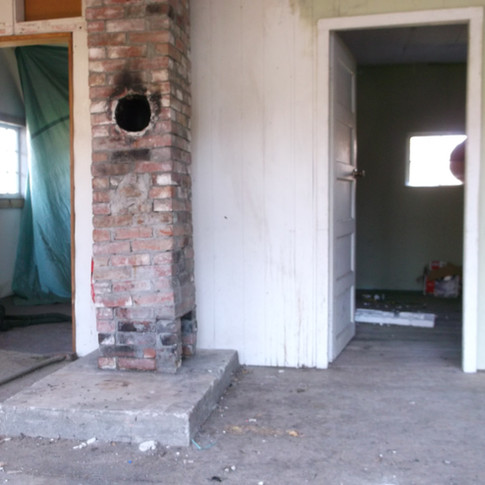















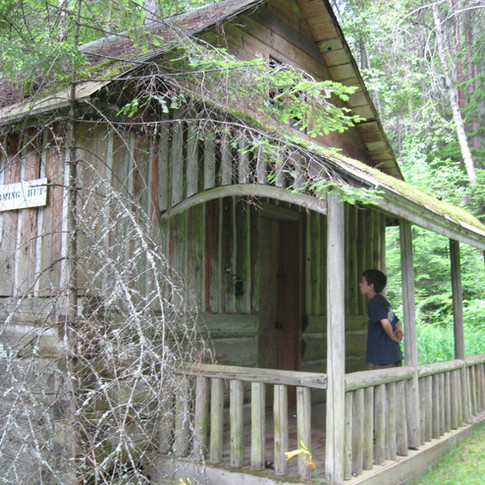





























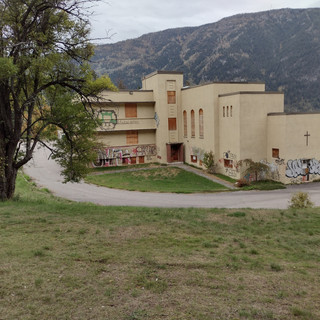















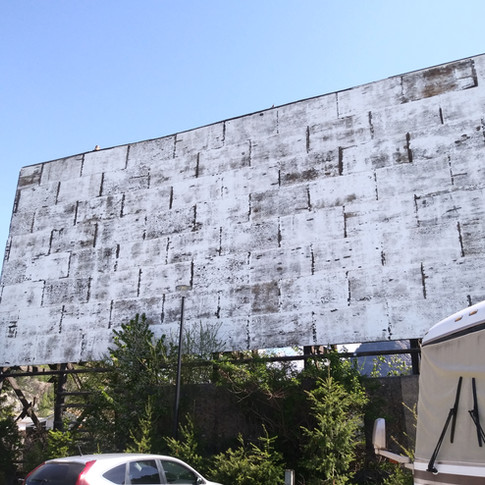















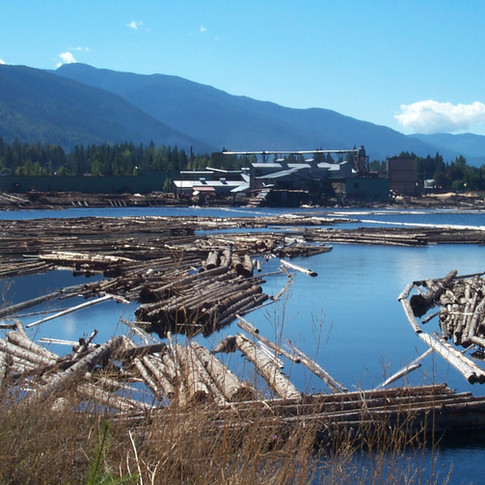





























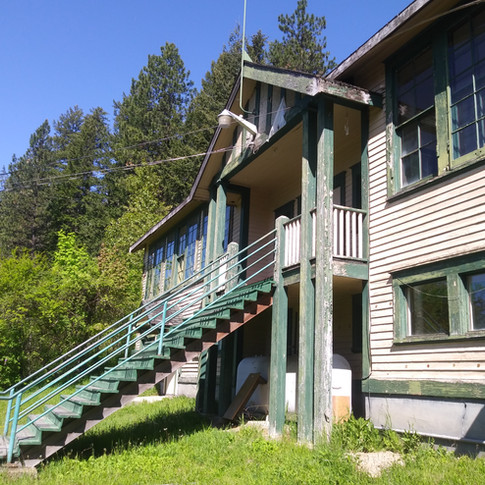











































You mention the Trail Museum as being on the site of the old Eagles building. I had to look on street view to find where that is because it is a while since I have been in Trail.
Am I correct in my memory that the Eagles building was the original Super Valu supermarket in the 1950s and was run by the Ferraro family?
Jim Sadler
My parents' house in Tadanac for about 40 years starting in 1969 was at 300 Kootenay Ave, while I was away at university and then living elsewhere for work. A common comment I made when I came for visits was to ask what happened to various buildings and landmarks, such as the Training Centre, Tadanac School, swimming pool, Tadanac Hall, and several houses across the street. While I was away they seemed to have disappeared one by one into thin air. I knew that circumstances had changed over the years for these various facilities, which was sad but understandable. For the Training Centre and the houses, I think Cominco just wanted them torn down completely to avoid any future liabi…
This brings back so many memories. I moved to Castlegar in 2000 and spent the next 10 years exploring most of these buildings from the road. In further years, sites like the Yakh Police Station and Ed Jordan’s Cabin disappeared. I had to stop and drive back and forth to ensure I hadn’t missed them. Same for the 2nd Dom at Ozeroff Village. So glad you captured these!
Awesome pictures and Iremember many of these old buildings. My dad, Bill Benwell, apprenticed under Ilsa Williams as an architect when Mt. St. Francis was being built. Shortly after he joined the B.C. Forest Service.
A glowing tribute to much of our region’s built history which though lost, was at least captured by your inquisitiveness and foresight. Amazing work.